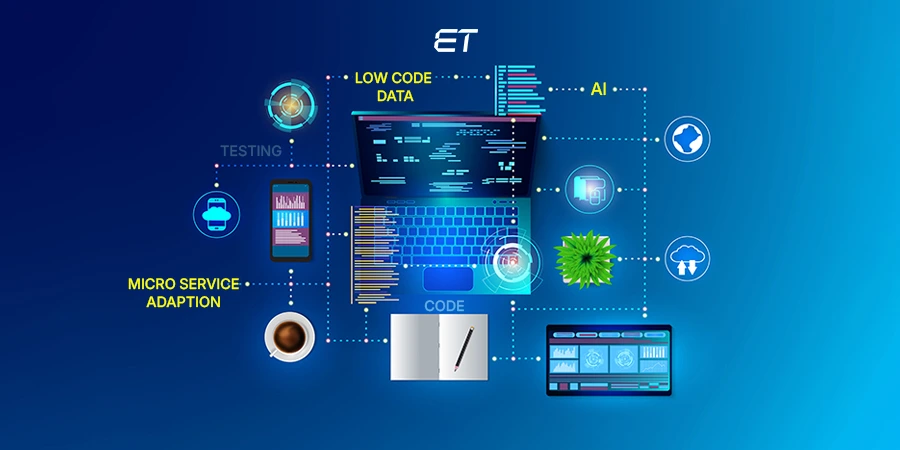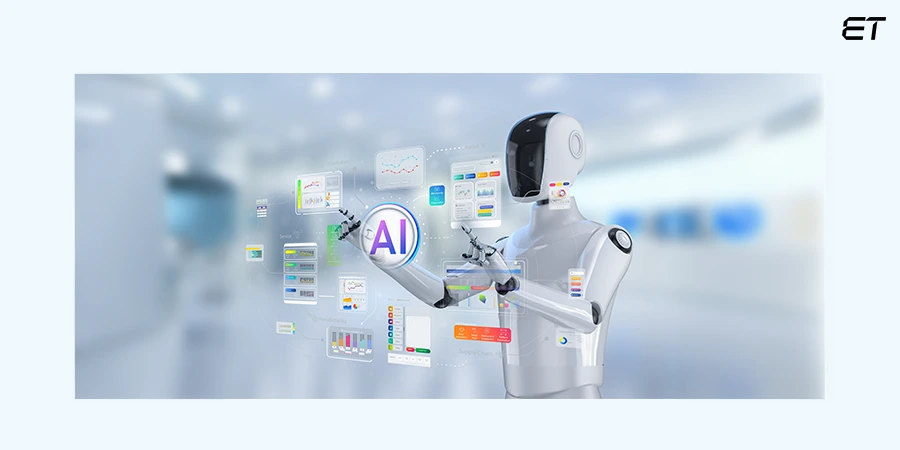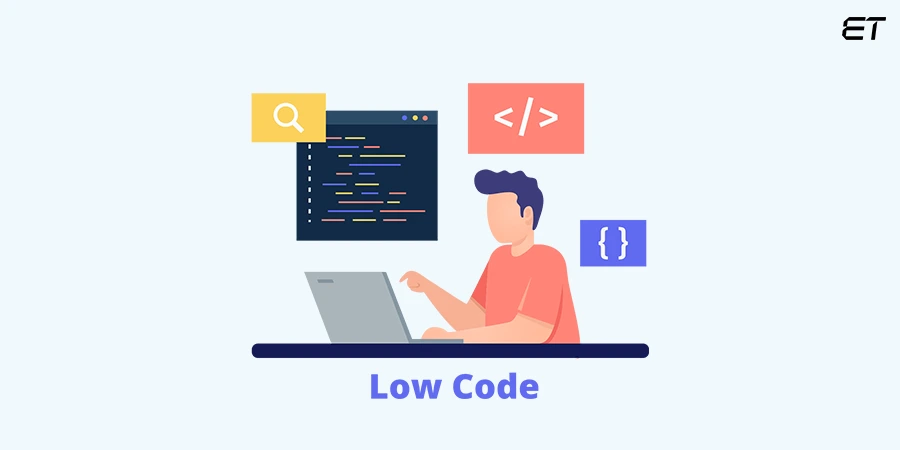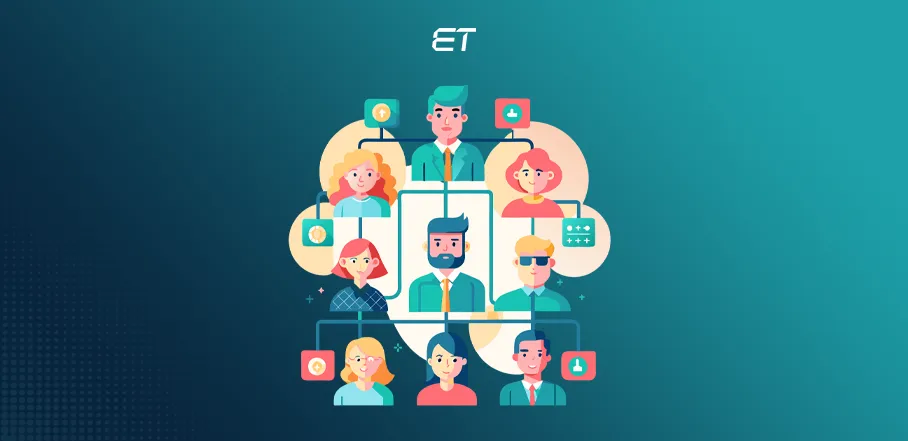
Decoding the Future: Software Development Industry Trends 2026
- Agentic AI tools will continue automating complex tasks with contextual reasoning.
- Low-code platforms will empower faster builds and non-developer contributions.
- Cloud-native and microservices will drive scalable, resilient architectures.
- Green coding might be essential for energy-efficient, sustainable software systems.
- Upskilling teams and modifying tech strategies is key to embracing such robust changes.
The global software development market is racing to reach USD 902.74 billion by 2030. This means more users, more problems, and more chances to build what’s next.
If you’re a CEO or tech leader, this opens a world of business opportunities. The only practical move is to constantly keep up with the latest software development industry trends 2026.
From the rise of agentic AI and cloud-native ecosystems to ever-increasing use of low-code tools, tech is scaling fast. So, you must understand each trend for proper adoption, innovation, and preparing teams accordingly.
We’ll unpack all the top software development trends in this blog so you stay updated and capitalize on them. Let’s start!
Transform your vision with future-ready software
Latest Trends in Software Development and Key figures 2026
Below, you’ll find some of the most prominent trends that are shaping this year and beyond.
1. Agentic AI and Its Multi-Domain Impact

One of the hottest software development industry trends 2026 is agentic AI and the rise of AI copilots. It’s expected that 33% of enterprise software platforms will use agentic AI in some form by 2028.
But why the hype?
Agentic AI tools not only assist but also act with context, reasoning, and adaptability. These AI agents can efficiently plan sprints, debug code, manage workflows, and even deploy software. All with minimal human input.
In a recent conversation with Rowan Cheung, Microsoft CEO Satya Nadella explained what agentic AI’s present and future looks like:
- Healthcare – AI agents will improve healthcare workflows, supporting tumor board meetings by collecting data from various sources. This leads to better, lower-cost healthcare.
- Developer Workflow – Coding agents like GitHub Copilot are assisting developers by generating code, explaining code, making multi-file edits, and full repository changes. That’s why Microsoft now generates 30% of new code with AI.
- Knowledge Work – AI agents can revolutionize knowledge work by automating tasks and providing comprehensive reports, freeing up workers for higher-level tasks.
- Proactive Agents – These agents proactively perform tasks, like summarizing emails offline on Copilot+ PCs, reducing user interaction friction.
These changes will give rise to new job roles like agent managers, who oversee AI agents to enhance productivity.
How to Prepare for These Trends as a Tech Leader
To stay ahead of these trends, build AI literacy across development, product, and operations teams:
- Invest in platforms that support agentic AI integration and upskill teams in prompt engineering.
- Build internal sandboxes or AI labs for safe experimentation with agentic workflows and copilots.
- Audit and refactor legacy codebases to make them more compatible with AI agents.
Also, redesign your AI development workflows to integrate agents properly.
Integrate Agentic AI via powerful frameworks
2. Cloud-Native Development to Power More Modern Software

The next entry on our software development industry trends 2026 list is cloud-native development and its increasing adoption.
Cloud-native development and microservices are becoming the gold standard for building scalable, resilient, and agile systems. As organizations prioritize speed and flexibility, these architectures help ship faster, recover quicker, and scale effortlessly.
As per a State of Cloud Native Development Q1 2026 report, there are over 9.2 million backend cloud-native developers. Plus, 93% of developers prefer cloud application deployment.
Other essential trends in this domain include:
- Microservices + AI – AI models are being modularized as microservices, allowing easier integration and independent scaling.
- Platform Engineering – Internal developer platforms are being built to abstract cloud complexity and standardize deployments.
- Edge-Native Capabilities – Edge computing combined with cloud-native allows low-latency processing closer to users. This will power more IoT and real-time apps.
- WebAssembly (WASM) on the Rise – WASM is becoming first-class in cloud-native, enabling lightweight, portable microservices, often orchestrated via Kubernetes.
Moreover, as cloud costs grow, teams will utilize FinOps (Financial Operations) and smarter design to build cost-efficient systems.
How to Prepare for These Trends as a Tech Leader
Preparing teams for these various trends needs a multi-step approach:
- Upskill engineering teams on Kubernetes and FaaS frameworks like AWS Lambda or Azure Functions.
- Experiment with WebAssembly (WASM) modules for high-performance, sandboxed microservices within Kubernetes clusters.
- Use tools like Backstage to build internal developer platforms that simplify cloud setups and speed up code deployment.
Designing systems for multi-cloud and hybrid flexibility is also essential.
3. Increasing Adoption of Low-Code Tools for Development

Low-code platforms are highly trending software tools, and their market valuation might cross USD 65 billion by 2027. Consequently, its adoption and usage will increase, making it one of the top software development industry trends 2026.
Why are companies so keen on adopting low-code dev platforms?
It’s mainly due to a few broad reasons. Companies need automation to scale and build faster. However, there’s a significant market gap for talented developers. Low-code and no-code tools help them fill this gap with high-quality development functionalities.
So, the low-code tools are slowly changing how companies view development. Here are some related trends to watch out for:
- Hyperautomation Integration – Low-code platforms are combining AI, ML, and RPA to automate complex, cross-department processes.
- AI‑enhanced Low‐Code Tools – Features like auto-generation, logic suggestion, and data integration are becoming standard.
- Industry‑specific Templates and Compliance Support – Platforms are offering vertical-tailored modules for sectors like healthcare and retail.
- Better Workflow Automation – Companies are experiencing improved productivity by automating repetitive coding tasks with these tools.
This way, more businesses will build apps independently, reducing IT backlog and accelerating delivery.
How to Prepare for These Trends as a Tech Leader
To handle these developments, start training teams on platform extensibility using custom code components. Other steps to follow include:
- Implement governance frameworks to manage citizen development securely.
- Standardize on enterprise-grade low-code platforms with compliance, RBAC, and audit trails.
- Define KPIs to evaluate scalability, maintainability, and ROI of low-code implementations.
These strategies will eventually reduce your development time and workload.
4. DevSecOps Driving the Future of Secure Software

When you’re dealing with cloud-native architectures, rising cyber threats, and faster release cycles, DevSecOps ensures security from day one. Developers are now making it a part of every SDLC stage.
The technology helps avoid security issues such as misconfigured infrastructure, dependency vulnerabilities, access control flaws, and unmonitored runtime threats. No wonder the DevSecOps market size might be USD 24.43 billion by 2029!
Let’s look at some key trends and happenings in this sector:
- Unified DevOps & MLOps Security – Companies are extending DevSecOps to machine learning pipelines, treating models as software artifacts to ensure security and governance.
- Runtime Protection & Monitoring – Observability features like real-time logging, anomaly detection, and guardrails are now becoming standard.
- Tackling Supply Chain Vulnerabilities – DevSecOps helps by securing pipelines and prioritizing real-time threats during deployment and runtime.
- Minimal Container Images and IaC (Infrastructure as Code) Usage – Using minimal container images reduces security risks by limiting unused components. DevSecOps promotes this and boosts security by automating infrastructure setup with IaC in AWS environments.
These advancements indicate that secure delivery will also become faster with DevSecOps.
How to Prepare for These Trends as a Tech Leader
To integrate DevSecOps properly into your SDLC (Software Development Life Cycle), follow these code-driven practices:
- Extend DevSecOps to MLOps (Machine learning operations) pipelines using version control, model validation, and policy-as-code for ML artifacts.
- Implement real-time observability with tools like OpenTelemetry and anomaly detection via ML-based threat models.
- Use smaller container images and tools like Terraform and AWS CDK to automate and monitor safe, consistent infrastructure setups.
Thus, you can prevent and address security issues that can hamper delivery later.
Get expert assistance to refine your DevOps strategies.
5. Augmented Reality Is No Longer a Niche Technology

Augmented Reality (AR) is no longer a novelty, but a strategic technology shaping enterprise innovation in 2026. With Apple Vision Pro and Meta’s AR glasses pushing boundaries, the market may surpass USD 62 billion by 2029.
It’s no surprise that multiple domains are adopting AR for business applications:
- Enterprise Adoption – Sectors like manufacturing and logistics are using AR for remote assistance and hands-free operations.
- WebAR and 5G Edge Delivery – Web-based AR is removing app dependency, while 5G enables low-latency, high-fidelity rendering at the edge.
- Medical Assistance – AR systems project medical images onto a patient during surgery to help doctors. VR systems simulate real-life scenarios to enhance physical functions among patients.
- Spatial Computing and AI Convergence – AR now combines computer vision and AI to recognize surroundings and provide real-time experiences tailored to the user’s environment.
So, for most business leaders, AR has become a key differentiator.
How to Prepare for These Trends as a Tech Leader
It’s essential to blend strategy with emerging tech capabilities to make the best use of AR:
- Invest in AR-capable infrastructure like spatial computing devices and 5G edge connectivity.
- Prioritize privacy and data governance in immersive AR use cases.
- Train teams on computer vision, generative AI, and AR development frameworks like ARKit or WebXR.
The future of AR is going to be diverse and competitive, so start building the foundation early.
6. Sustainable Software Engineering Leading the Green Tech Revolution

One of the most distinctive software development industry trends 2026 is the rise of sustainable engineering and green tech. Market experts predict that the global green tech and sustainability market will reach USD 73.9 billion by 2030.
The reason behind this expansion is to design systems that consume less power without compromising performance or scalability. Green code and sustainable engineering focus on writing energy-efficient software, optimizing resource use, and reducing carbon footprint.
Leading organizations are focusing on such environment-friendly development practices:
- Google is cutting data center emissions by 12% since 2024, while boosting compute energy efficiency. They’re also building gadgets like the Pixel Watch 3 with recycled material.
- Amazon is the largest corporate buyer of renewable energy, with over 600 renewable energy projects globally. Their initiative, The Climate Pledge, aims to achieve net-zero carbon emissions by 2040.
Other green tech trends that are reshaping the industry include:
- Energy-First Design – Algorithms and data structures are now evaluated for power efficiency, not just performance.
- Cloud Optimization with Renewables – Scheduling workloads in regions with renewable energy minimizes the environmental impact.
Thus, sustainable tech solutions are the way to a cleaner yet technically developed future.
How to Prepare for These Trends as a Tech Leader
If you’re planning to embrace green tech or enhance your existing initiatives, follow these steps:
- Shift to serverless and microservices to reduce idle compute and scale resources dynamically.
- Deploy workloads in regions powered by renewable energy through cloud carbon-aware scheduling.
- Monitor carbon emissions in real time and adjust systems to reduce energy use.
Moreover, spread awareness about green tech practices among your workforce.
7. Connected Intelligence Transforming the IoT Landscape

IoT (Internet of Things) is evolving from connected devices to intelligent autonomous systems. This explains its market surge as the number of IoT devices may exceed 40.6 billion by 2034.
Some IoT software development industry trends 2026 to check out in this dynamic market:
- IoT Cybersecurity – As more devices connect, using zero-trust security, real-time threat detection, and encrypted updates is now essential for protection.
- The Rise of AIoT – AI is now built into most industrial IoT systems, helping them detect problems early and maintenance issues.
- Digital Twins and Real-Time Simulation – Digital twins are becoming common, helping businesses create virtual models of systems to predict issues and improve performance.
- IoT, 5G, and Edge Computing – IoT devices use 5G and edge computing to transmit data instantly, enabling real-time automation in smart cities and industrial systems.
Gradually, IoT will be a part of more enterprise strategies as business demands increase.
How to Prepare for These Trends as a Tech Leader
You have to align infrastructure, security, and intelligence systematically to ride IoT’s next wave:
- Build digital twin platforms for real-time system simulation and optimization.
- Enforce zero-trust security across IoT firmware, APIs, and network layers.
- Deploy 5G-ready edge infrastructure for low-latency processing near data sources.
Such readiness will ensure your systems stay smart and secure while integrating IoT.
Learn how our IoT solutions offered 43% brand growth
Final Thoughts – Software Development Industry Trends 2026
In 2026, software development is more about building intelligent, secure, scalable, and sustainable ecosystems than just writing code.
From agentic AI copilots, low-code acceleration to cloud-native agility, the software development industry is reshaped by automation, context-awareness, and resilience.
AR and IoT are extending digital experiences into the physical world, while green coding is prioritizing sustainability. These software development industry trends 2026 require a change in how you think about technology and transformation.
So, to keep up with the current trends in software platforms, be prepared, adopt early, and integrate wisely.
Ready to build for 2026 and beyond?
Frequently Asked Questions
1. How is security evolving in the global software development industry?
In 2026, developers embed security early on with DevSecOps, AI-driven threat detection, and zero-trust models. Continuous monitoring across the software supply chain and runtime environments is also a key component of modern security practices.
2. How do AI tools shape software development industry trends 2026?
According to software development industry trends 2026, AI is accelerating coding, testing, debugging, and documentation through automation. AI also powers context-aware agents that execute tasks independently.
3. Will software development industry trends 2026 reshape team roles and responsibilities?
Yes, software development industry trends 2026 will change organizational roles, introducing agent managers and more citizen developers. Employees will require cross-functional skills to handle AI tools and automation pipelines.
4. What are the top three trends in the software engineering industry?
As per the latest software development industry statistics and facts, the top 3 trends are –
- AI-native software development
- Increased adoption of low-code and no-code tools
- The evolution of Blockchain technology
The future of software development looks promising, as companies might invest more in R&D to adopt these changes.



